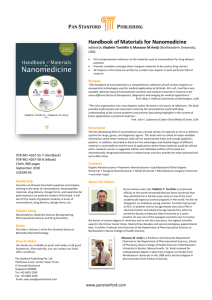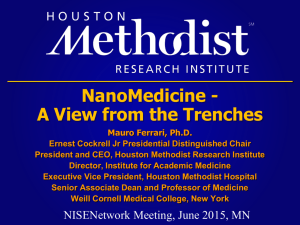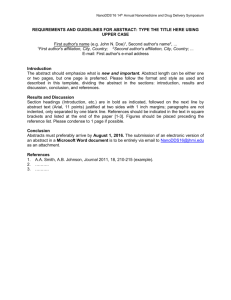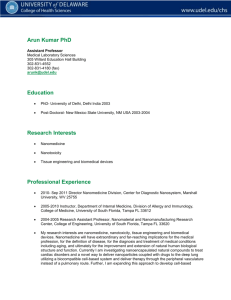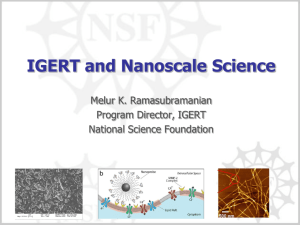Heather Brodkin Computationally Guided Protein
advertisement
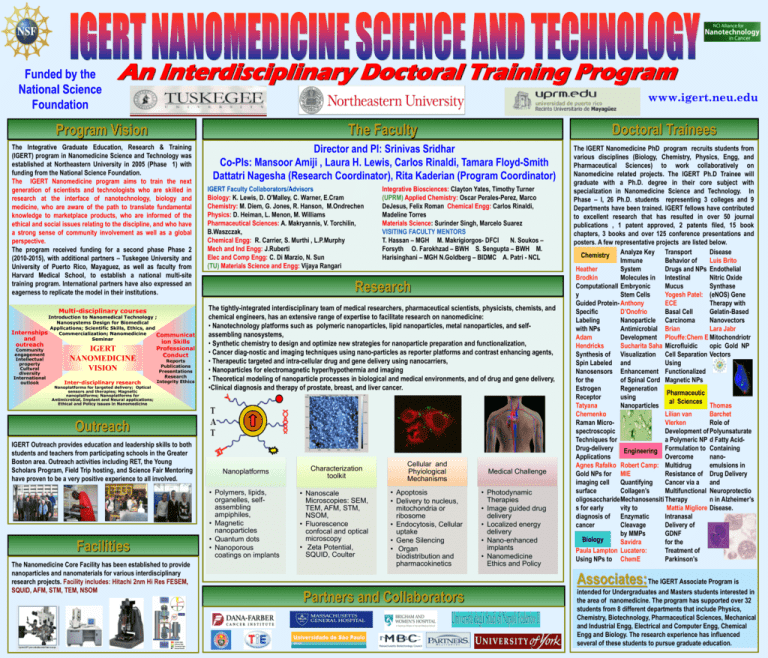
Funded by the National Science Foundation An Interdisciplinary Doctoral Training Program www.igert.neu.edu Program Vision The Faculty Doctoral Trainees The Integrative Graduate Education, Research & Training (IGERT) program in Nanomedicine Science and Technology was established at Northeastern University in 2005 (Phase 1) with funding from the National Science Foundation. The IGERT Nanomedicine program aims to train the next generation of scientists and technologists who are skilled in research at the interface of nanotechnology, biology and medicine, who are aware of the path to translate fundamental knowledge to marketplace products, who are informed of the ethical and social issues relating to the discipline, and who have a strong sense of community involvement as well as a global perspective. The program received funding for a second phase Phase 2 (2010-2015), with additional partners – Tuskegee University and University of Puerto Rico, Mayaguez, as well as faculty from Harvard Medical School, to establish a national multi-site training program. International partners have also expressed an eagerness to replicate the model in their institutions. Director and PI: Srinivas Sridhar Co-PIs: Mansoor Amiji , Laura H. Lewis, Carlos Rinaldi, Tamara Floyd-Smith Dattatri Nagesha (Research Coordinator), Rita Kaderian (Program Coordinator) The IGERT Nanomedicine PhD program recruits students from various disciplines (Biology, Chemistry, Physics, Engg, and Pharmaceutical Sciences) to work collaboratively on Nanomedicine related projects. The IGERT Ph.D Trainee will graduate with a Ph.D. degree in their core subject with specialization in Nanomedicine Science and Technology. In Phase – I, 26 Ph.D. students representing 3 colleges and 9 Departments have been trained. IGERT fellows have contributed to excellent research that has resulted in over 50 journal publications , 1 patent approved, 2 patents filed, 15 book chapters, 3 books and over 125 conference presentations and posters. A few representative projects are listed below. Analyze Key Transport Disease Chemistry Immune Behavior of Luis Brito Heather System Drugs and NPs Endothelial Brodkin Molecules in Intestinal Nitric Oxide Computationall Embryonic Mucus Synthase y Stem Cells Yogesh Patel: (eNOS) Gene Guided Protein- Anthony ECE Therapy with Specific D’Onofrio Basal Cell Gelatin-Based Labeling Nanoparticle Carcinoma Nanovectors with NPs Antimicrobial Brian Lara Jabr Adam Development Plouffe:Chem E Mitochondriotr Hendricks Sucharita Saha Microfluidic opic Gold NP Synthesis of Visualization Cell Separation Vectors Spin Labeled and Using Nanosensors Enhancement Functionalized for the of Spinal Cord Magnetic NPs Estrogen Regeneration Pharmaceutic Receptor using al Sciences Tatyana Nanoparticles Thomas Chernenko Lilian van Barchet Raman MicroVlerken Role of spectroscopic Development of Polyunsaturate Techniques for a Polymeric NP d Fatty AcidDrug-delivery Engineering Formulation to Containing Applications Overcome nanoAgnes Rafalko Robert Camp: Multidrug emulsions in Gold NPs for MIE Resistance of Drug Delivery imaging cell Quantifying Cancer via a and surface Collagen’s Multifunctional Neuroprotectio oligosaccharide Mechanosensiti Therapy n in Alzheimer’s s for early vity to Mattia Migliore Disease. diagnosis of Enzymatic Intranasal cancer Cleavage Delivery of by MMPs GDNF Biology Savidra for the Paula Lampton Lucatero: Treatment of Using NPs to ChemE Parkinson’s Multi-disciplinary courses Introduction to Nanomedical Technology ; Nanosystems Design for Biomedical Applications; Scientific Skills, Ethics, and Internships Commercialization; Nanomedicine Communicat and Seminar outreach Community engagement Intellectual property Cultural diversity International outlook IGERT NANOMEDICINE VISION Inter-disciplinary research ion Skills Professional Conduct Reports Publications Presentations Research Integrity Ethics Nanoplatforms for targeted delivery; Optical sensors and therapies; Magnetic nanoplatforms; Nanoplatforms for Antimicrobial, Implant and Neural applications; Ethical and Policy issues in Nanomedicine IGERT Faculty Collaborators/Advisors Biology: K. Lewis, D. O'Malley, C. Warner, E.Cram Chemistry: M. Diem, G. Jones, R. Hanson, M.Ondrechen Physics: D. Heiman, L. Menon, M. Williams Pharmaceutical Sciences: A. Makryannis, V. Torchilin, B.Waszczak, Chemical Engg: R. Carrier, S. Murthi , L.P.Murphy Mech and Ind Engg: J.Ruberti Elec and Comp Engg: C. Di Marzio, N. Sun (TU) Materials Science and Engg: Vijaya Rangari Integrative Biosciences: Clayton Yates, Timothy Turner (UPRM) Applied Chemistry: Oscar Perales-Perez, Marco DeJesus, Felix Roman Chemical Engg: Carlos Rinaldi, Madeline Torres Materials Science: Surinder Singh, Marcelo Suarez VISITING FACULTY MENTORS T. Hassan – MGH M. Makrigiorgos- DFCI N. Soukos – Forsyth O. Farokhzad – BWH S. Sengupta – BWH M. Harisinghani – MGH N.Goldberg – BIDMC A. Patri - NCL Research The tightly-integrated interdisciplinary team of medical researchers, pharmaceutical scientists, physicists, chemists, and chemical engineers, has an extensive range of expertise to facilitate research on nanomedicine: • Nanotechnology platforms such as polymeric nanoparticles, lipid nanoparticles, metal nanoparticles, and selfassembling nanosystems, • Synthetic chemistry to design and optimize new strategies for nanoparticle preparation and functionalization, • Cancer diag-nostic and imaging techniques using nano-particles as reporter platforms and contrast enhancing agents, • Therapeutic targeted and intra-cellular drug and gene delivery using nanocarriers, • Nanoparticles for electromagnetic hyper/hypothermia and imaging • Theoretical modeling of nanoparticle processes in biological and medical environments, and of drug and gene delivery, •Clinical diagnosis and therapy of prostate, breast, and liver cancer. Outreach IGERT Outreach provides education and leadership skills to both students and teachers from participating schools in the Greater Boston area. Outreach activities including RET, the Young Scholars Program, Field Trip hosting, and Science Fair Mentoring have proven to be a very positive experience to all involved. Facilities The Nanomedicine Core Facility has been established to provide nanoparticles and nanomaterials for various interdisciplinary research projects. Facility includes: Hitachi 2nm Hi Res FESEM, SQUID, AFM, STM, TEM, NSOM Nanoplatforms • Polymers, lipids, organelles, selfassembling ampiphiles, • Magnetic nanoparticles • Quantum dots • Nanoporous coatings on implants Characterization toolkit • Nanoscale Microscopies: SEM, TEM, AFM, STM, NSOM, • Fluorescence confocal and optical microscopy • Zeta Potential, SQUID, Coulter Cellular and Phyiological Mechanisms • Apoptosis • Delivery to nucleus, mitochondria or ribosome • Endocytosis, Cellular uptake • Gene Silencing • Organ biodistribution and pharmacokinetics Medical Challenge • Photodynamic Therapies • Image guided drug delivery • Localized energy delivery • Nano-enhanced implants • Nanomedicine Ethics and Policy Associates: The IGERT Associate Program is Partners and Collaborators intended for Undergraduates and Masters students interested in the area of nanomedicine. The program has supported over 32 students from 8 different departments that include Physics, Chemistry, Biotechnology, Pharmaceutical Sciences, Mechanical and Industrial Engg, Electrical and Computer Engg, Chemical Engg and Biology. The research experience has influenced several of these students to pursue graduate education.
